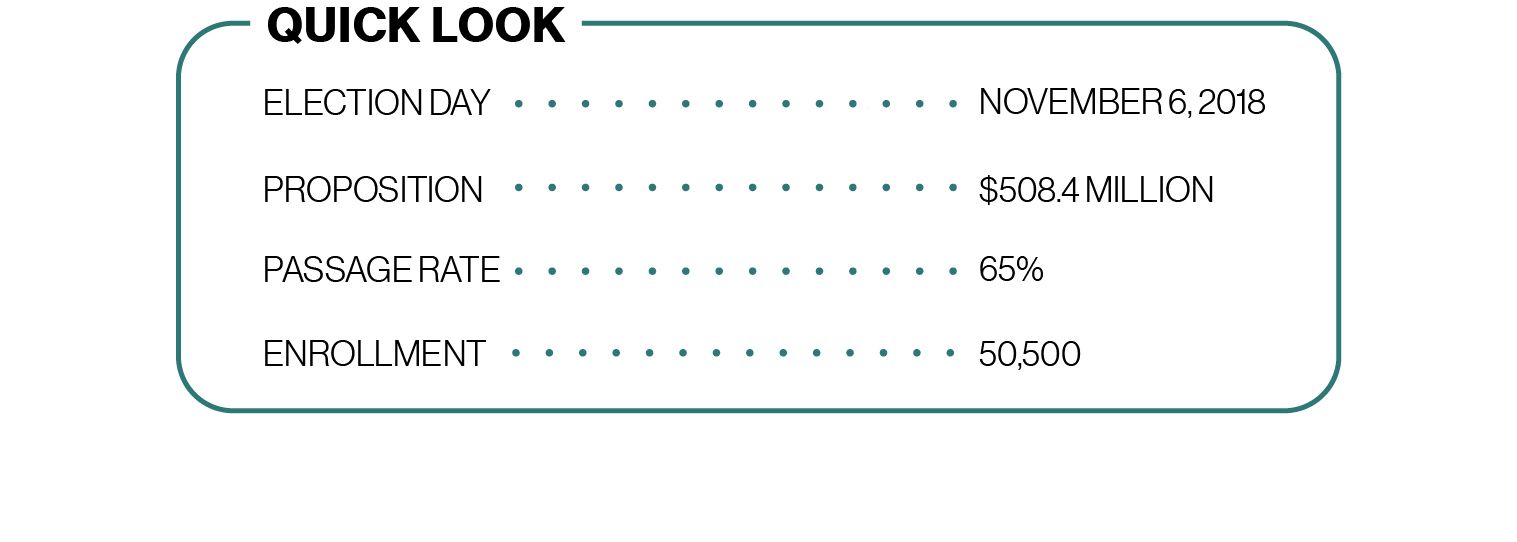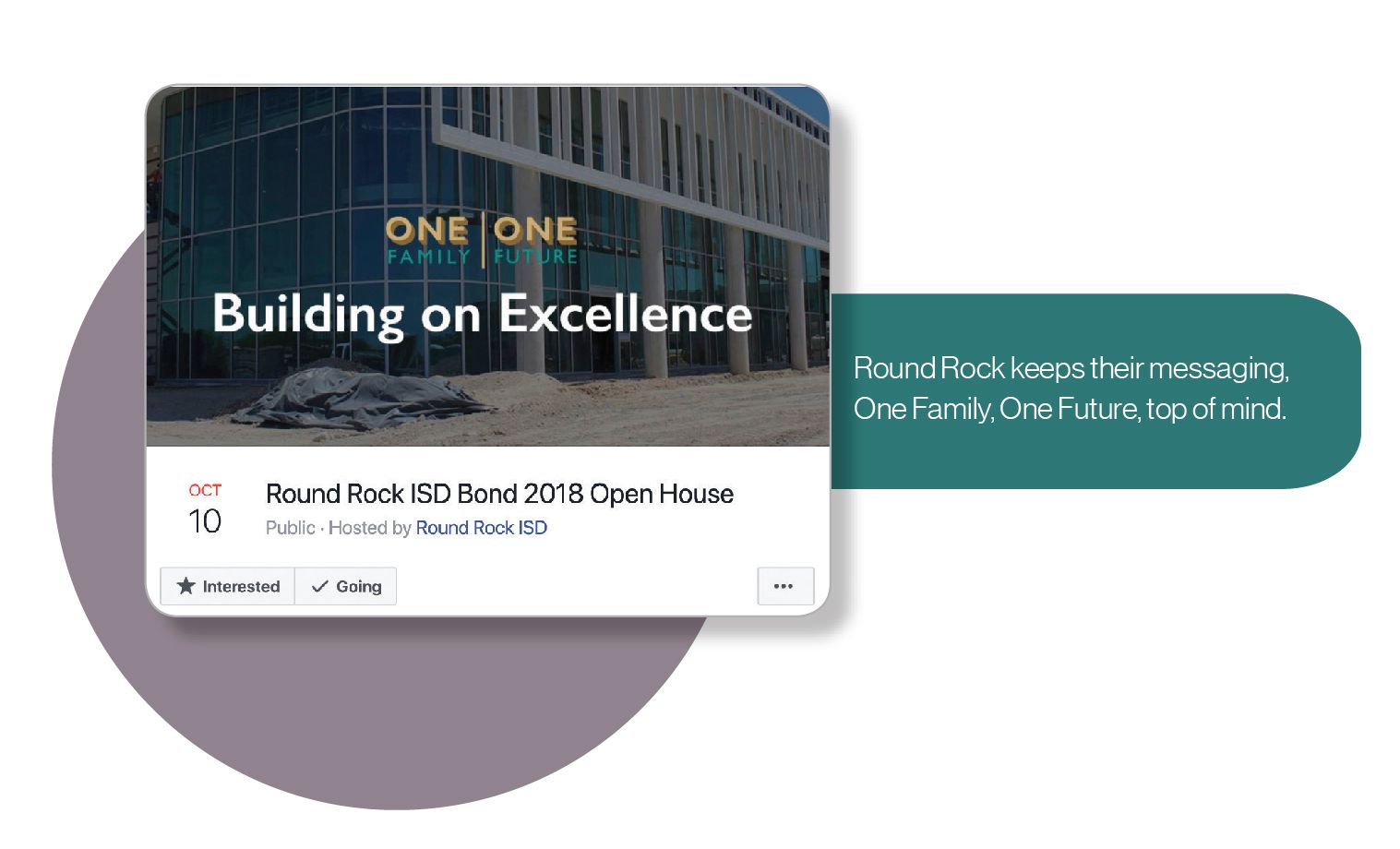Bond Campaign Deep Dive: Round Rock ISD
Learning from Failure · Involving the Community · Branding the District · Leveraging Advocates · Personalizing Communications · Engaging the Media


When Jenny LaCoste-Caputo entered her role at Round Rock ISD in September 2017, the district was still recovering from a major setback. That May, despite a history of successful referendums, they’d lost a critical bond vote worth $572 million.
“It really shook the district,” LaCoste-Caputo tells SchoolCEO. “There was a lot of concern about some pressing facilities needs”—buildings crowded by the already-large district’s rapid growth. “It was just a nonnegotiable that we would have to go out for another bond really soon,” she says.“The question was how soon.” As the district’s new Executive Director of Communications and Community Relations, it would be LaCoste-Caputo’s job to lead that charge.
“Cool,” she says with a laugh. “No pressure.”
Lessons from Round Rock:
- If you failed before, find out why.
- Community engagement is messy, but worth it.
- Building a positive brand is the ultimate campaign strategy.
- Leverage your advocates.
- Keep communications personal.
- Get the media on board.
If you failed before, find out why.
Why did that 2017 bond fail? One factor was timing. “It’s been kind of a foregone conclusion that May is a great time for a school bond election,” LaCoste-Caputo explains. “Hardly anything else is on the ballot, and if you really rally your supporters to go out there, you’ll pass it.”
However, Round Rock’s supporters didn’t hit the polls that particular May. When they later surveyed the community about their feelings toward the district, “it all came back very favorable,” says LaCoste-Caputo. “We found that the majority of our community supported us, but they weren’t at the polls in May of ‘17.”
A deeper problem, they realized, was a lack of community ownership. The district had told their community what they needed instead of first asking for input.“Everything seemedso neat and obvious that we didn’t do enough to make the community feellike they had buy-in,” LaCoste-Caputo says. “So we had to throw that beautiful plan out of the window.”
“We found that innovative programs are all well and good, but people wanted to take care of what they saw as the basics: address growth, address safety, do renovations where renovations were needed.”
Community engagement is messy, but worth it.
The Round Rock team started the bond process all over again, shooting for a November 2018 election. This time, instead of assigning the planning process to administration, they embarked on what they called “a strategic plan refresh”—passing the power back to the community. In February of 2018, the team organized the first of several community planning meetings. “We basically invited anyone in the community who wanted to participate,” says LaCoste-Caputo. About 150 people, on average, turned out each time.
After breakouts, brainstorms, and thousands of sticky notes, the district came up with a new strategic plan. “It wasn’t terribly different,” LaCoste-Caputo says, “but we knew it had community buy-in.” That April, many of those regular attendees became members of the district’s Citizen Bond Committee, or CBC—the group that would actually make the bond recommendation to the school board.
At first, LaCoste-Caputo found the CBC “frustrating, as a district administrator, because it felt like organized chaos.” The committee called the shots, taking the decision-making power away from district administration.
“From the outside, it could look a little disorganized, but in reality it was completely grassroots. They were making the decisions,” she says. “It made the process messier, it made it longer, but it was absolutely worth it. It’s their money! It’s their district!” What’s more, the CBC process showed Round Rock who their most passionate advocates were. “We really realized that people who showed up day in, day out had the best interests for the district at heart,” she says.
The recommendation the CBC presented to the board looked a lot like the 2017 bond package—but with a few significant changes. For example, where the previous bond had proposed replacing an aging middle school with a fine arts campus, the new one asked only to rebuild the traditional school. “We found that innovative programs are all well and good, but people wanted to take care of what they saw as the basics in this bond: address growth, address safety, do renovations where renovations were needed,” says LaCoste-Caputo. “They weren’t interested in what they saw as a fancy new school with a specific focus.”
Even more important than these strategic changes was the community ownership the district had created. Because the CBC had built the bond package themselves, “they were completely invested in it,” LaCoste-Caputo says. “We knew they would be ambassadors for this bond.”
Building a positive brand is the ultimate campaign strategy.
The process of building support for the district began long before the bond election was called. It started the moment LaCoste-Caputo first began revamping their communications strategy.
“We wanted to really leverage our reputation,” she says. “Coming from the outside, I knew nothing but positive things about Round Rock ISD. This is a great district—the 21st largest in Texas—and it’s growing. We’re nationally recognized on all kinds of levels.”
When it came time to decide on a slogan for the campaign to educate voters on the bond, the Round Rock team decided to “really capitalize and focus on that reputation of excellence,” says LaCoste-Caputo. “We know we have a great school district. They’re banging down the doors to get in here—that’s why we need a bond.” The bond’s theme, “Building on Excellence,” spoke to the need to keep up the district’s impressive growth. “We have this strong foundation and we need to keep it going,” she says.
But an organized opposition to the district was working hard to damage that stellar reputation, and based on the results of the 2017 bond, they were succeeding, at least to some degree. “This very small, but vocal, opposition had really kind of shaken the confidence of district leadership,” LaCoste-Caputo says. So from the get-go, she focused on telling the district’s great stories: “strengthening the brand, making sure people identified the brand with things that were positive.”
Leverage your advocates.
“In Texas, it’s clear and specific that we as a district cannot advocate for a bond,” LaCoste-Caputo says. “We can encourage people to vote, we can educate people about the bond, but we can’t advocate.” Add to that challenge the small but vocal opposition, who weren’t limited in how they communicated. Both issues demanded that the district take advantage of an outside force: their community advocates.
LaCoste-Caputo says Round Rock’s advocates emerged “pretty organically.” When the 2017 bond failed, “it took everyone by surprise,” she says. “They just assumed it would win. So our advocates were fired up and ready to help us.”
And these advocates certainly pulled more than their weight in the bond campaign—particularly in keeping tabs on the opposition group’s campaign and where they were spreading misinformation. One such place was Nextdoor, a private social network built for neighborhood residents to post updates about break-ins or lost pets in the area. The problem was that district administration couldn’t log in to every neighborhood’s Nextdoor. “So the school district didn’t have access to share our own story or correct misinformation,” LaCoste-Caputo explains.
But Round Rock’s detractors were posting on Nextdoor. “They were trying to push this narrative of distrust and mismanagement,” LaCoste-Caputo says. They bashed the bond package from all sides, denying the validity of the zero tax increase and the necessity of new facilities. Luckily, Round Rock’s advocates were on Nextdoor too, ready to defend the district—but many advocates weren’t sure of how to do so. “Our ambassadors didn’t want to get drawn into this ugly, public back-and-forth,” says LaCoste-Caputo.
So the district developed a new system. Advocates kept a finger on the pulse of the community, both on Nextdoor and beyond, taking note of spreading misinformation or festering concerns. Then, they reported back to the district.
“Basically they helped guide our content and what we knew we needed to address,” LaCoste-Caputo says. Based on advocates’ feedback, the Round Rock team created videos and other content to target specific community questions.
Round Rock ISD: Tax Rate ImpactIf passed, Bond 2018 is not expected to impact Round Rock ISD's tax rate. How is that possible? Learn more here:
Geplaatst door Round Rock ISD op Donderdag 20 september 2018
Then, advocates could respond to negativity with links to official district communications. “We felt like it gave our advocates this arsenal of information, so they didn’t have to be the experts, and they didn’t have to get drawn into the conversation,” she says. Round Rock empowered their advocates to defend the district easily and accurately, “without repeating the negative, without getting into a back-and-forth conflict.”
“You’re not going to change the mind of the person who made the post. That’s not the point,” LaCoste-Caputo says. “The point is: Who are they influencing? You want to have the reasonable-sounding person weighing in.” And thanks to the advocates’ recon and the professionalism of the district’s communications, Round Rock could come out on top in just about every public confrontation.
Want to learn more about advocates? Go to schoolceo.com/advocates
Keep communications personal.
When it came to educating the community about the bond, LaCoste-Caputo knew to deliver communications through familiar faces and channels, sharing the message as personally as possible.
“We found that direct email is the best marketing outreach tool, especially when it’s personalized,” LaCoste-Caputo says. First, the emails targeted the concerns of each specific audience, telling families how the bond would affect their particular school. But they also came “from the principal, instead of from the superintendent or the district, because that’s who parents know,” she adds.
Email isn’t the only way principals acted as the bond’s “standard bearers.” Once the district had crafted an official bond presentation, they didn’t just send central office administrators out to present it. “We trained all our principals,” says LaCoste-Caputo. “We gave them a step-by-step guide on how to to do their presentations, how to focus on their campuses.” Then, working with their PTAs, each principal would present the bond information to their respective school’s parents.
“I was just drawing on my experiences as a parent and who I’m more likely to pay attention to,” says LaCoste-Caputo. “I know what my kids’ principal looks like. Most people can’t name their superintendent.”
In fact, Round Rock worked to keep all their bond-related events personal and positive. Their informational meetings, for example, were “a departure from 2017.” Instead of panel-style town hall meetings with open Q&As, they opted for a more conversational, one-on-one setup for questions and answers.
“In 2017, the district administrators looked like they were in front of a firing squad,” LaCoste-Caputo says. “They would mostly get the people who were upset coming to every single one. If media came, it wasn’t going to look good. We obviously wanted to have the chance to talk to our public and inform them about the bond, but that just doesn’t seem like the best way. It becomes this adversarial situation.”
So instead of town halls, Round Rock held “open houses.” They set up booths with poster boards and other informational materials for every major project in the bond, each managed by a subject matter expert. “So our maintenance director would be the one talking about the need for HVAC improvements,” she explains. “We might have our security director at the one about safety and security.” Attendees could rotate through the booths, talking face-to-face with Round Rock ISD employees, getting their specific questions answered in a low-pressure setting.
“You could actually have a conversation,” says LaCoste-Caputo. “And the conversations that took place were super deep and meaningful, much more so than in a traditional setup.”
Get the media on board.
Before coming to Round Rock ISD, LaCoste-Caputo spent 15 years in journalism, serving as the education editor for the San Antonio Express-News. “I’ve covered a lot of school bond elections,” she says, “and I know what the media is looking for. They want angles.” So as the district team went about their bond campaign, she kept that focus on angles in the back of her mind. “We thought of every piece of content that we created for all channels as a pitch to the media as well,” she says.
Of course, that’s nothing new. LaCoste-Caputo was building district relationships with the media long before the campaign hit full swing. “I’ve got credibility with them,” she says.“When they ask for information about the district, I respond. They know they can count on me.” Why work to build that trust? “It’s building capital so that you can take a withdrawal when you need to,” she says. “When you call or email them with that story pitch, they’re way more willing to listen to you because you have that relationship.”
If there was ever a time to cash in on that capital, it was for this bond. So LaCoste-Caputo did. And she gave the media what she knew they wanted—an angle.
“Our schools are so dang good that people keep moving here, and now we have a school that was built to accommodate 900 elementary students filled with almost 1300,” she tells SchoolCEO. “A lot of districts don’t want to share that information, because they don’t think it looks good, but it’s our reality. That’s a story that gets the media out here”—and it gave the Round Rock team a chance to talk, on air, about the bond.
“Of course, our opposition was doing the same thing, calling in with a negative spin—especially after we were getting positive media coverage,” she adds. “But again, that’s where that relationship building came in. While they might give the opposition airtime, they’re always going to call us to make sure they have both sides of the story, because we have that credibility.”
When Election Day finally came, the largest bond in Round Rock’s history succeeded—with a 65% pass rate.
Now, as they did during the campaign, the Round Rock ISD team is working hard to keep their community involved in the bond process, sharing updates on their bond-specific website. “Every time our board votes to pick the designer on a new elementary school or approves the purchase of new school buses, we’re pushing that out,” she says.
For LaCoste-Caputo, the bond’s success is the perfect extension of the district’s theme: One Family, One Future. “As a community, we all collectively share the same future,” she says. “What’s more of an investment in the future than an investment in public education?”


SchoolCEO is free for K-12 school leaders. Subscribe below to stay connected with us!

